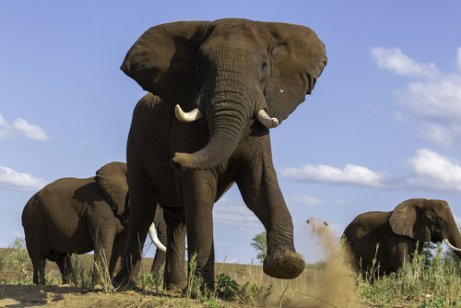What is Elephant Musth?


Written and verified by the vet Eugenio Fernández Suárez
In spite of being peaceful animals, during elephant musth, the male becomes very aggressive.
Even though elephants tend to be kindly creatures, there is a period of time in which the male of this species isn’t in a good mood, to put it mildly. This period of time is known as musth. During this time the male truly suffers and can be very dangerous for anyone who crosses his path.
What exactly is musth in elephants?
At this time in a male elephant’s life, testosterone reaches levels that are several times more than normal. During these peaks of testosterone, the male elephant becomes aggressive, charges and attacks other animals and may attack people. Oddly enough, they may even target trees.
Even though it seems like elephant musth is linked to heat in a female, this is actually improbable. The reason being that it doesn’t correlate time-wise to when the female is in heat. During musth, these animals tend to produce a secretion in their temporal glands that are situated behind the eyes.

It’s thought that this secretion could be one of the descendants of fear musth in elephants. Interesting to note, the temporal glands increase in size during this period. This causes acute pain in the eyes.
At this time, male elephants produce a certain sound that resembles responding to the request of a female in heat. But this isn’t the case. In fact, one of the hypotheses is that this period of fury allows the elephants to establish changes in dominance.
What happens during elephant musth?
Curiously, it seems that musth is more intense in young elephants. This is especially true for those that have not had parents present in their lives, which shows that they depend on previous generations. This situation forces orphaned elephants to change homes.
Some of the young males attack other species, such as rhinoceros. They may even go on rampages in populated areas. However, the presence of older male elephants helps to avoid this situation.

Musth also occurs in animals in captivity, which is a problem for zoos, of course. In India, where the Mahouts people have elephants for labor, it’s common for the owners to chain them to prevent dangerous activity.
Normally, during this time people isolate elephants so that they don’t harm other elephants or people. In some cases, elephant musth can last up to two months, even though the very dangerous episodes last only about one month. When it comes to older animals, musth fades away and is no longer an issue.
The fact is that no one truly knows the reason behind this behavior in male elephants. In spite of elephant musth, these are very sensitive creatures that don’t have an aggressive tendency. Nevertheless, this unusual behavior is very dangerous and at the same time fascinating.
In spite of being peaceful animals, during elephant musth, the male becomes very aggressive.
Even though elephants tend to be kindly creatures, there is a period of time in which the male of this species isn’t in a good mood, to put it mildly. This period of time is known as musth. During this time the male truly suffers and can be very dangerous for anyone who crosses his path.
What exactly is musth in elephants?
At this time in a male elephant’s life, testosterone reaches levels that are several times more than normal. During these peaks of testosterone, the male elephant becomes aggressive, charges and attacks other animals and may attack people. Oddly enough, they may even target trees.
Even though it seems like elephant musth is linked to heat in a female, this is actually improbable. The reason being that it doesn’t correlate time-wise to when the female is in heat. During musth, these animals tend to produce a secretion in their temporal glands that are situated behind the eyes.

It’s thought that this secretion could be one of the descendants of fear musth in elephants. Interesting to note, the temporal glands increase in size during this period. This causes acute pain in the eyes.
At this time, male elephants produce a certain sound that resembles responding to the request of a female in heat. But this isn’t the case. In fact, one of the hypotheses is that this period of fury allows the elephants to establish changes in dominance.
What happens during elephant musth?
Curiously, it seems that musth is more intense in young elephants. This is especially true for those that have not had parents present in their lives, which shows that they depend on previous generations. This situation forces orphaned elephants to change homes.
Some of the young males attack other species, such as rhinoceros. They may even go on rampages in populated areas. However, the presence of older male elephants helps to avoid this situation.

Musth also occurs in animals in captivity, which is a problem for zoos, of course. In India, where the Mahouts people have elephants for labor, it’s common for the owners to chain them to prevent dangerous activity.
Normally, during this time people isolate elephants so that they don’t harm other elephants or people. In some cases, elephant musth can last up to two months, even though the very dangerous episodes last only about one month. When it comes to older animals, musth fades away and is no longer an issue.
The fact is that no one truly knows the reason behind this behavior in male elephants. In spite of elephant musth, these are very sensitive creatures that don’t have an aggressive tendency. Nevertheless, this unusual behavior is very dangerous and at the same time fascinating.
All cited sources were thoroughly reviewed by our team to ensure their quality, reliability, currency, and validity. The bibliography of this article was considered reliable and of academic or scientific accuracy.
- Poole, J. H. (1987). Rutting behavior in African elephants: the phenomenon of musth. Behaviour, 102(3-4), 283-316.
- Keerthipriya, P., Nandini, S., Gautam, H., Revathe, T., & Vidya, T. N. C. (2020). Musth and its effects on male–male and male–female associations in Asian elephants. Journal of Mammalogy, 101(1), 259-270.
- LaDue, C. A., Schulte, B. A., Kiso, W. K., & Freeman, E. W. (2021). Musth and sexual selection in elephants: A review of signalling properties and potential fitness consequences. Behaviour, 159(3-4), 207-242.
- Poole, J. H. (1989). Announcing intent: the aggressive state of musth in African elephants. Animal Behaviour, 37, 140-152.
- LaDue, C. A., Vandercone, R. P., Kiso, W. K., & Freeman, E. W. (2022). Behavioral characterization of musth in Asian elephants (Elephas maximus): Defining progressive stages of male sexual behavior in in-situ and ex-situ populations. Applied Animal Behaviour Science, 251, 105639.
This text is provided for informational purposes only and does not replace consultation with a professional. If in doubt, consult your specialist.








